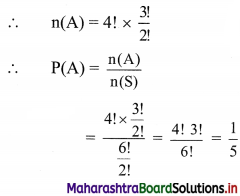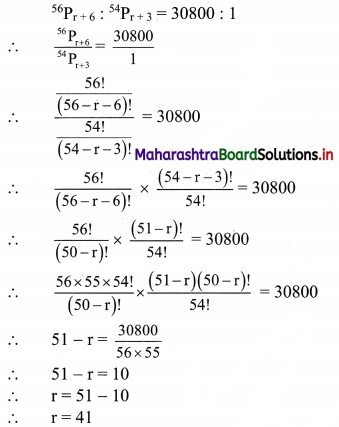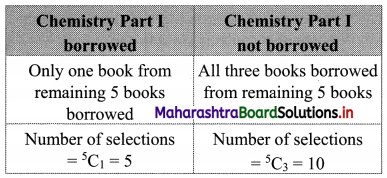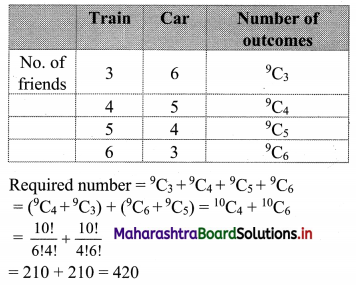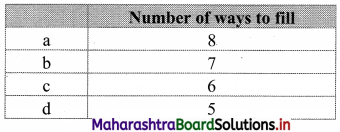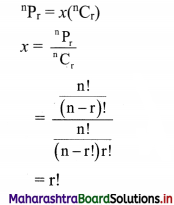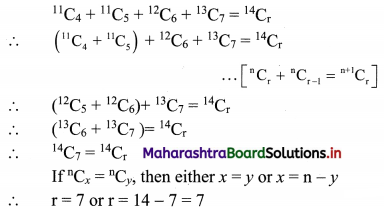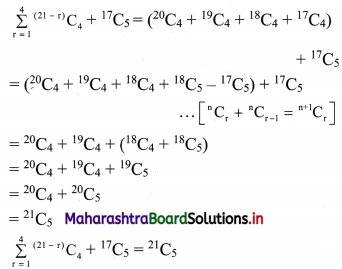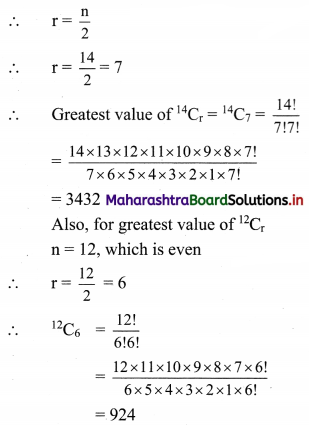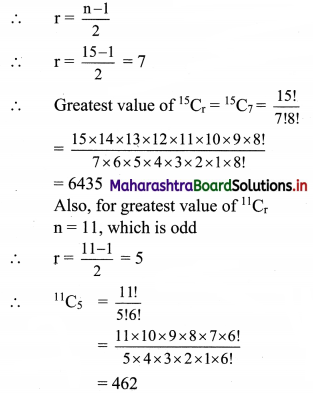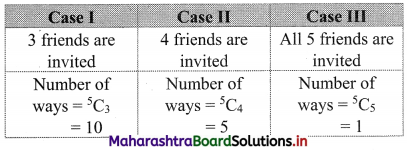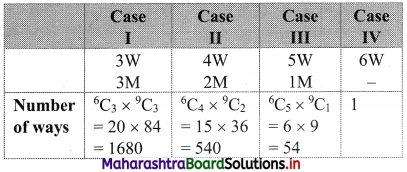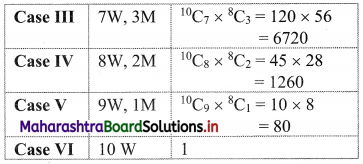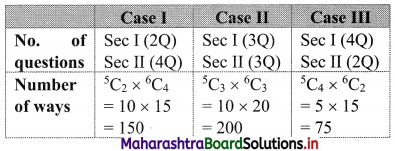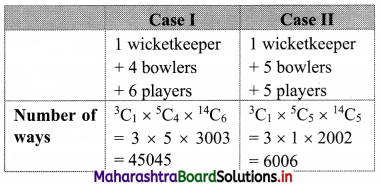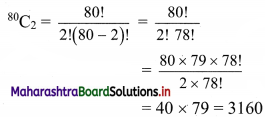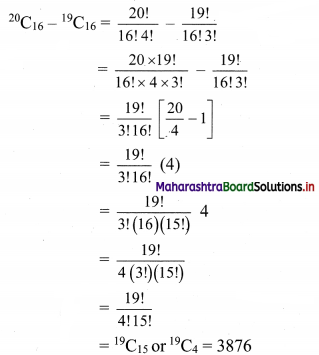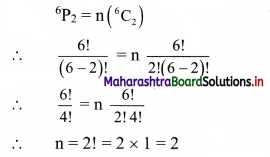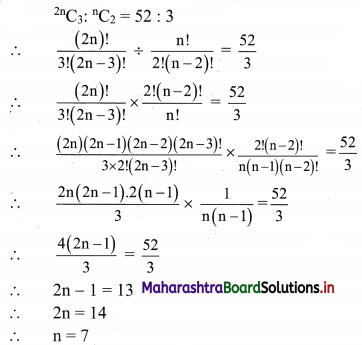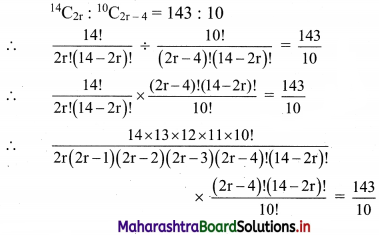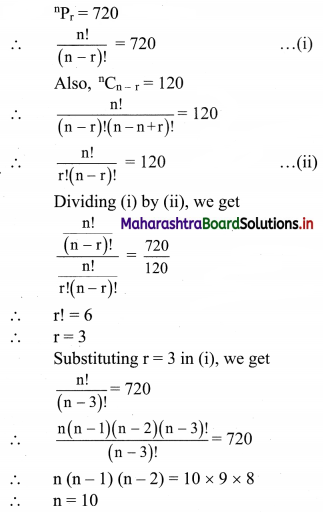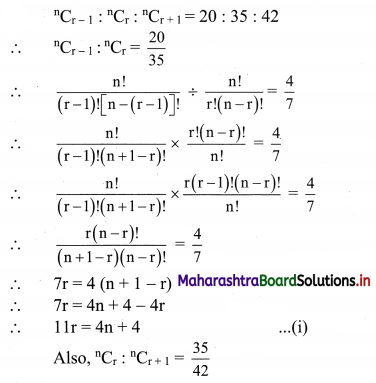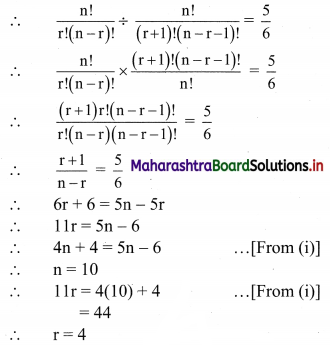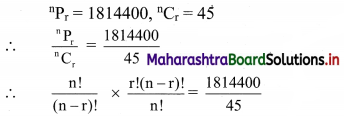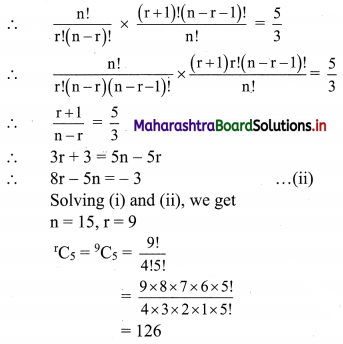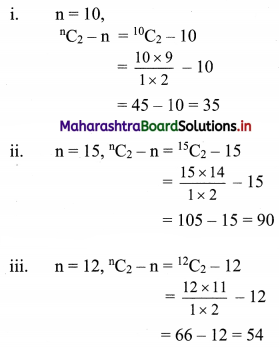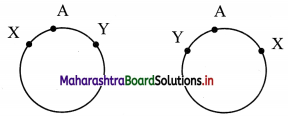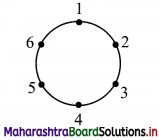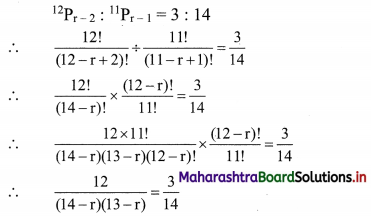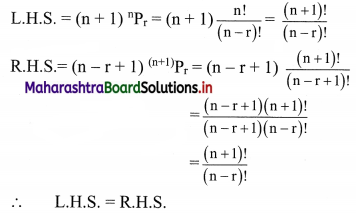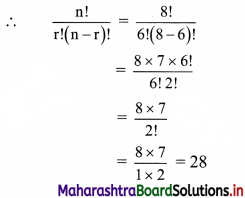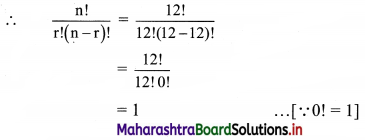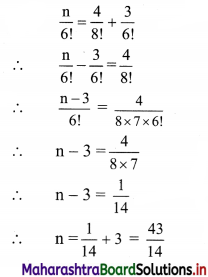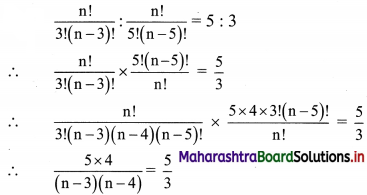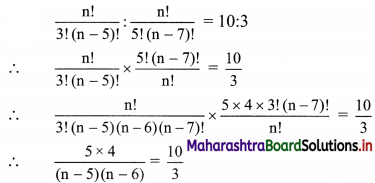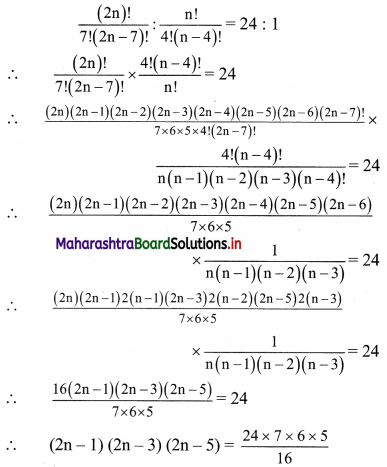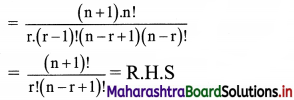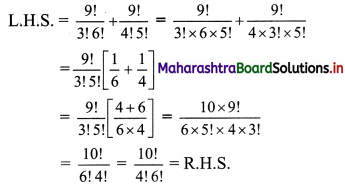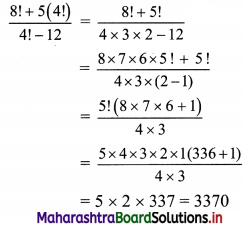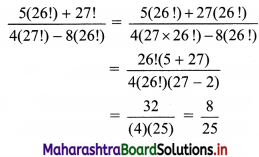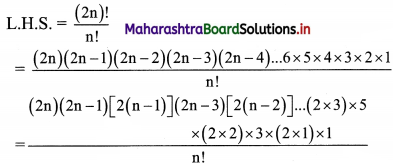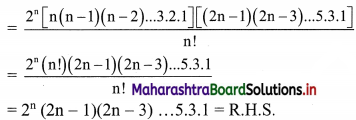Balbharati Maharashtra State Board 11th Commerce Maths Solution Book Pdf Chapter 7 Probability Ex 7.2 Questions and Answers.
Maharashtra State Board 11th Commerce Maths Solutions Chapter 7 Probability Ex 7.2
Question 1.
A fair die is thrown two times. Find the chance that
(i) product of the numbers on the upper face is 12.
(ii) sum of the numbers on the upper face is 10.
(iii) sum of the numbers on the upper face is at least 10.
(iv) sum of the numbers on the upper face is 4.
(v) the first throw gives an odd number and the second throw gives a multiple of 3.
(vi) both the times die to show the same number (doublet).
Solution:
If a fair die is thrown twice, the sample space is
S = {(1, 1), (1, 2), (1, 3), (1, 4), (1, 5), (1, 6), (2, 1), (2, 2), (2, 3), (2, 4), (2, 5), (2, 6), (3, 1), (3, 2), (3, 3), (3, 4), (3, 5), (3, 6), (4, 1), (4, 2), (4, 3), (4, 4), (4, 5), (4, 6), (5, 1), (5, 2), (5, 3), (5, 4), (5, 5), (5, 6), (6, 1), (6, 2), (6, 3), (6, 4), (6, 5), (6, 6)}
∴ n(S) = 36
(i) Let A be the event that the product of the numbers on uppermost face is 12.
∴ A = {(2, 6), (3, 4), (4, 3), (6, 2)}
∴ n(A) = 4
∴ P(A) = \(\frac{\mathrm{n}(\mathrm{A})}{\mathrm{n}(\mathrm{S})}=\frac{4}{36}=\frac{1}{9}\)
(ii) Let B be the event that sum of the numbers on uppermost face is 10.
∴ B = {(4, 6), (5, 5), (6, 4)}
∴ n(B) = 3
∴ P(B) = \(\frac{n(B)}{n(S)}=\frac{3}{36}=\frac{1}{12}\)
(iii) Let C be the event that sum of the numbers on uppermost face is at least 10 (i.e., 10 or more than 10 which are 10 or 11 or 12)
∴ C = {(4, 6), (5, 5), (5, 6), (6, 4), (6, 5), ( 6, 6)}
∴ n(C) = 6
∴ P(C) = \(\frac{\mathrm{n}(\mathrm{C})}{\mathrm{n}(\mathrm{S})}=\frac{6}{36}=\frac{1}{6}\)
(iv) Let D be the event that sum of the numbers on uppermost face is 4.
∴ D = {(1, 3), (2, 2), (3, 1)}
∴ n(D) = 3
∴ P(D) = \(\frac{\mathrm{n}(\mathrm{D})}{\mathrm{n}(\mathrm{S})}=\frac{3}{36}=\frac{1}{12}\)
(v) Let E be the event that 1st throw gives an odd number and 2nd throw gives multiple of 3.
∴ E = {(1, 3), (1, 6), (3, 3), (3, 6), (5, 3), (5, 6)}
∴ n(E) = 6
∴ P(E) = \(\frac{\mathrm{n}(\mathrm{E})}{\mathrm{n}(\mathrm{S})}=\frac{6}{36}=\frac{1}{6}\)
(vi) Let F be the event that both times die shows same number.
∴ F = {(1, 1), (2, 2), (3, 3), (4, 4), (5, 5), (6, 6)}
∴ n(F) = 6
∴ P(F) = \(\frac{\mathrm{n}(\mathrm{F})}{\mathrm{n}(\mathrm{S})}=\frac{6}{36}=\frac{1}{6}\)
![]()
Question 2.
Two cards are drawn from a pack of 52 cards. Find the probability that
(i) both are black.
(ii) both are diamonds.
(iii) both are ace cards.
(iv) both are face cards.
(v) one is a spade and the other is a non-spade.
(vi) both are from the same suit.
(vii) both are from the same denomination.
Solution:
Two cards can be drawn from a pack of 52 cards in 52C2 ways.
∴ n(S) = 52C2
(i) Let A be the event that both the cards drawn are black.
The pack of 52 cards contains 26 black cards.
∴ 2 cards can be drawn from them in 26C2 ways
∴ n(A) = 26C2
∴ P(A) = \(\frac{\mathrm{n}(\mathrm{A})}{\mathrm{n}(\mathrm{S})}=\frac{{ }^{26} \mathrm{C}_{2}}{{ }^{52} \mathrm{C}_{2}}\)
(ii) Let B be the event that both the cards drawn are diamond.
There are 13 diamond cards in a pack of 52 cards.
∴ 2 diamond cards can be drawn from 13 diamond cards in 13C2 ways
∴ n(B) = 13C2
∴ P(B) = \(\frac{\mathrm{n}(\mathrm{B})}{\mathrm{n}(\mathrm{S})}=\frac{{ }^{13} \mathrm{C}_{2}}{{ }^{52} \mathrm{C}_{2}}\)
(iii) Let C be the event that both the cards drawn are aces.
In a pack of 52 cards, there are 4 ace cards.
∴ 2 ace cards can be drawn from 4 ace cards in 4C2 ways
∴ n(C) = 4C2
∴ P(C) = \(\frac{\mathrm{n}(\mathrm{C})}{\mathrm{n}(\mathrm{S})}=\frac{{ }^{4} \mathrm{C}_{2}}{{ }^{52} \mathrm{C}_{2}}\)
(iv) Let D be the event that both the cards drawn are face cards.
There are 12 face cards in a pack of 52 cards.
∴ 2 face cards can be drawn from 12 face cards in 12C2 ways.
∴ n(D) = 12C2
∴ P(D) = \(\frac{\mathrm{n}(\mathrm{D})}{\mathrm{n}(\mathrm{S})}=\frac{{ }^{12} \mathrm{C}_{2}}{{ }^{52} \mathrm{C}_{2}}\)
(v) Let E be the event that out of the two cards drawn one is a spade and other is non-spade.
There are 13 spade cards and 39 cards are non-spade cards in a pack of 52 cards.
∴ One spade card can be drawn from 13 spade cards in 13C1 ways and one non-spade card can be drawn from 39 non-spade cards in 39C1 ways.
∴ n(E) = 13C1 . 39C1
∴ P(E) = \(\frac{\mathrm{n}(\mathrm{E})}{\mathrm{n}(\mathrm{S})}=\frac{{ }^{13} \mathrm{C}_{1} \cdot{ }^{39} \mathrm{C}_{1}}{{ }^{52} \mathrm{C}_{2}}\)
(vi) Let F be the event that both the cards drawn are of the same suit.
A pack of 52 cards consists of 4 suits each containing 13 cards.
2 cards can be drawn from a suit in 13C2 ways.
A suit can be selected in 4 ways.
∴ n(F) = 13C2 × 4
∴ P(F) = \(\frac{\mathrm{n}(\mathrm{F})}{\mathrm{n}(\mathrm{S})}=\frac{4 \times{ }^{13} \mathrm{C}_{2}}{{ }^{52} \mathrm{C}_{2}}\)
(vii) Let G be the event that both the cards drawn are of same denominations.
A pack of cards has 13 denominations and 4 different cards for each denomination
∴ n(G) = 13 × 4C2
∴ P(G) = \(\frac{\mathrm{n}(\mathrm{G})}{\mathrm{n}(\mathrm{S})}=\frac{13 \times{ }^{4} \mathrm{C}_{2}}{{ }^{52} \mathrm{C}_{2}}\)
![]()
Question 3.
Four cards are drawn from a pack of 52 cards. Find the probability that
(i) 3 are Kings and 1 is Jack.
(ii) all the cards are from different suits.
(iii) at least one heart.
(iv) all cards are club and one of them is a jack.
Solution:
4 cards can be drawn out of 52 cards in 52C4 ways.
∴ n(S) = 52C4
(i) Let A be the event that out of the four cards drawn, 3 are kings and 1 is a jack.
There are 4 kings and 4 jacks in a pack of 52 cards.
∴ 3 kings can be drawn from 4 kings in 4C3 ways.
Similarly, 1 jack can be drawn out of 4 jacks in 4C1 ways.
∴ Total number of ways in which 3 kings and 1 jack can be drawn is 4C3 × 4C1
∴ n(A) = 4C3 × 4C1
∴ P(A) = \(\frac{\mathrm{n}(\mathrm{A})}{\mathrm{n}(\mathrm{S})}=\frac{{ }^{4} \mathrm{C}_{3} \times{ }^{4} \mathrm{C}_{1}}{{ }^{52} \mathrm{C}_{4}}\)
(ii) Let B be the event that all the cards drawn are of different suits.
A pack of 52 cards consists of 4 suits each containing 13 cards.
∴ A card can be drawn from each suit in 13C1 ways.
∴ 4 cards can be drawn from 4 different suits in 13C1 × 13C1 × 13C1 × 13C1 ways.
∴ n(B) = 13C1 × 13C1 × 13C1 × 13C1
∴ P(B) = \(\frac{\mathrm{n}(\mathrm{B})}{\mathrm{n}(\mathrm{S})}=\frac{{ }^{13} \mathrm{C}_{1} \times{ }^{13} \mathrm{C}_{1} \times{ }^{13} \mathrm{C}_{1} \times{ }^{13} \mathrm{C}_{1}}{{ }^{52} \mathrm{C}_{4}}\)
(iii) Let C be the event that out of the four cards drawn at least one is a heart.
∴ C’ is the event that all 4 cards drawn are non-heart cards.
In a pack of 52 cards, there are 39 non-heart cards.
∴ 4 non-heart cards can be drawn in 39C4 ways.
∴ n(C’) = 39C4
∴ P(C’) = \(\frac{\mathrm{n}\left(\mathrm{C}^{\eta}\right)}{\mathrm{n}(\mathrm{S})}=\frac{{ }^{39} \mathrm{C}_{4}}{{ }^{52} \mathrm{C}_{4}}\)
∴ P(C) = 1 – P(C’) = 1 – \(\frac{{ }^{39} \mathrm{C}_{4}}{{ }^{52} \mathrm{C}_{4}}\)
(iv) Let D be the event that all the 4 cards drawn are clubs and one of them is a jack.
In a pack of 52 cards, there are 13 club cards having 1 jack card.
∴ 1 jack can be drawn in 1C1 way and the other 3 cards can be drawn from remaining 12 club cards in 12C3 ways.
∴ n(D) = 12C3 × 1C1
∴ P(D) = \(\frac{\mathrm{n}(\mathrm{D})}{\mathrm{n}(\mathrm{S})}=\frac{{ }^{12} \mathrm{C}_{3} \times{ }^{1} \mathrm{C}_{1}}{{ }^{52} \mathrm{C}_{4}}\)
Question 4.
A bag contains 15 balls of three different colours: Green, Black, and Yellow. A ball is drawn at random from the bag. The probability of a green ball is 1/3. The probability of yellow is 1/5.
(i) What is the probability of blackball?
(ii) How many balls are green, black, and yellow?
Solution:
(i) The bag contains 15 balls of three different colours i.e., green (G), black (B) and yellow (Y)
∴ P(G) = \(\frac{1}{3}\) and P(Y) = \(\frac{1}{5}\)
If a ball is drawn from the bag, then it can be any one of the green, black and yellow.
∴ P(G) + P(B) + P(Y) = 1
∴ \(\frac{1}{3}\) + P(B) + \(\frac{1}{5}\) = 1
∴ P(B) + \(\frac{8}{15}\) = 1
∴ P(B) = 1 – \(\frac{8}{15}\) = \(\frac{7}{15}\)
∴ Probability of black ball is \(\frac{7}{15}\)
(ii) Total number of balls = 15 and
P(G) = \(\frac{1}{3}\), P(B) = \(\frac{7}{15}\), P(Y) = \(\frac{1}{5}\)
∴ number of green balls = \(\frac{1}{3}\) × 15 = 5
number of black balls = \(\frac{7}{15}\) × 15 = 7
and number of yellow balls = \(\frac{1}{5}\) × 15 = 3.
![]()
Question 5.
A box contains 75 tickets numbered 1 to 75. A ticket is drawn at random from the box. What is the probability that the
(i) number on the ticket is divisible by 6?
(ii) number on the ticket is a perfect square?
(iii) number on the ticket is prime?
(iv) number on the ticket is divisible by 3 and 5?
Solution:
The box contains 75 tickets numbered 1 to 75.
∴ 1 ticket can be drawn from the box in 75C1 = 75 ways.
∴ n(S) = 75
(i) Let A be the event that number on ticket is divisible by 6.
∴ A = {6, 12, 18, 24, 30, 36, 42, 48, 54, 60, 66, 72}
∴ n(A) = 12
∴ P(A) = \(\frac{\mathrm{n}(\mathrm{A})}{\mathrm{n}(\mathrm{S})}=\frac{12}{75}=\frac{4}{25}\)
(ii) Let B be the event that number on ticket is a perfect square.
∴ B = {1, 4, 9, 16, 25, 36, 49, 64}
∴ n(B) = 8
∴ P(B) = \(\frac{\mathrm{n}(\mathrm{B})}{\mathrm{n}(\mathrm{S})}=\frac{8}{75}\)
(iii) Let C be the event that the number on the ticket is a prime number.
∴ C = {2, 3, 5, 7, 11, 13, 17, 19, 23, 29, 31, 37, 41, 43, 47, 53, 59, 61, 67, 71, 73}
∴ n(C) = 21
∴ P(C) = \(\frac{\mathrm{n}(\mathrm{C})}{\mathrm{n}(\mathrm{s})}=\frac{21}{75}=\frac{7}{25}\)
(iv) Let D be the event that number on ticket is divisible by 3 and 5 i.e., divisible by L.C.M. of 3 and 5 i.e., 15
∴ D = {15, 30, 45, 60, 75}
∴ n(D) = 5
∴ P(D) = \(\frac{\mathrm{n}(\mathrm{D})}{\mathrm{n}(\mathrm{S})}=\frac{5}{75}=\frac{1}{15}\)
Question 6.
From a group of 8 boys and 5 girls, a committee of five is to be formed. Find the probability that the committee contains
(i) 3 boys and 2 girls
(ii) at least 3 boys.
Solution:
The group consists of 8 boys and 5 girls i.e., 8 + 5 = 13 persons.
A committee of 5 is to be formed from this group.
∴ 5 persons from 13 persons can be selected in 13C5 ways
∴ n(S) = 13C5
(i) Let A be the event that the committee contains 3 boys and 2 girls.
3 boys from 8 boys can be selected in 8C3 ways and 2 girls from 5 girls can be selected in 5C2 ways
∴ n(A) = 8C3 . 5C2
∴ P(A) = \(\frac{\mathrm{n}(\mathrm{A})}{\mathrm{n}(\mathrm{S})}=\frac{{ }^{8} \mathrm{C}_{3} \cdot{ }^{5} \mathrm{C}_{2}}{{ }^{13} \mathrm{C}_{5}}\)
(ii) Let B be the event that the committee contains at least 3 boys (i.e., 3 boys and 2 girls or 4 boys and 1 girl or 5 boys and no girl)
∴ n(B) = 8C3 . 5C2 + 8C4 . 5C1 + 8C5 . 5C0
∴ P(B) = \(\frac{\mathrm{n}(\mathrm{B})}{\mathrm{n}(\mathrm{S})}=\frac{{ }^{8} \mathrm{C}_{3} \cdot{ }^{5} \mathrm{C}_{2}+{ }^{8} \mathrm{C}_{4} \cdot{ }^{5} \mathrm{C}_{1}+{ }^{8} \mathrm{C}_{5} \cdot{ }^{5} \mathrm{C}_{0}}{{ }^{13} \mathrm{C}_{5}}\)
![]()
Question 7.
A room has three sockets for lamps. From a collection of 10 light bulbs of which 6 are defective, a person selects 3 bulbs at random and puts them in a socket. What is the probability that the room is lit?
Solution:
Total number of bulbs = 10
Number of defective bulbs = 6
∴ Number of non-defective bulbs = 4
3 bulbs can be selected out of 10 light bulbs in 10C3 ways.
∴ n(S) = 10C3
Let A be the event that room is lit.
∴ A’ is the event that the room is not lit.
For A’ the bulbs should be selected from the 6 defective bulbs.
This can be done in 6C3 ways.
∴ n(A’) = 6C3
∴ P(A’) = \(\frac{\mathrm{n}\left(\mathrm{A}^{\prime}\right)}{\mathrm{n}(\mathrm{S})}=\frac{{ }^{6} \mathrm{C}_{3}}{{ }^{10} \mathrm{C}_{3}}\)
∴ P(Room is lit) = 1 – P(Room is not lit)
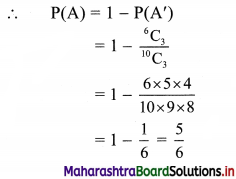
Question 8.
The letters of the word LOGARITHM are arranged at random. Find the probability that
(i) Vowels are always together.
(ii) Vowels are never together.
(iii) Exactly 4 letters between G and H
(iv) begins with O and ends with T
(v) Start with a vowel and ends with a consonant.
Solution:
There are 9 letters in the word LOGARITHM.
These letters can be arranged among themselves in 9P9 = 9! ways.
∴ n(S) = 9!
(i) Let A be the event that vowels are always together.
The word LOGARITHM consists of 3 vowels (O, A, I) and 6 consonants (L, G, R, T, H, M).
3 vowels can be arranged among themselves in = 3P3 = 3! ways.
Considering 3 vowels as one group, 6 consonants and this group (i.e., altogether 7) can be arranged in 7P7 = 7! ways.
∴ n(A) = 3! × 7!
∴ P(A) = \(\frac{\mathrm{n}(\mathrm{A})}{\mathrm{n}(\mathrm{S})}=\frac{3 ! \times 7 !}{9 !}\)
(ii) Let B be the event that vowels are never together.
Consider the following arrangement
_C_C_C_C_C_C_
6 consonants create 7 gaps.
∴ 3 vowels can be arranged in 7 gaps in 7P3 ways.
Also 6 consonants can be arranged among themselves in 6P6 = 6! ways.
∴ n(B) = 6! × 7P3
∴ P(B) = \(\frac{\mathrm{n}(\mathrm{B})}{\mathrm{n}(\mathrm{S})}=\frac{6 ! \times{ }^{7} \mathrm{P}_{3}}{9 !}\)
(iii) Let C be the event that exactly 4 letters are arranged between G and H.
Consider the following arrangement
1 2 3 4 5 6 7 8 9
∴ Out of 9 places, G and H can occupy any one of following 4 positions in 4 ways.
1st and 6th, 2nd and 7th, 3rd and 8th, 4th and 9th
Now, G and H can be arranged among themselves in 2P2 = 2! =2 ways.
Also, the remaining 7 letters can be arranged in remaining 7 places in 7P7 = 7! ways.
∴ n(C) = 4 × 2 × 7! = 8 × 7! = 8!
∴ P(C) = \(\frac{\mathrm{n}(\mathrm{C})}{\mathrm{n}(\mathrm{S})}=\frac{8 !}{9 !}=\frac{8 !}{9 \times 8 !}=\frac{1}{9}\)
(iv) Let D be the event that word begins with O and ends with T.
Thus first and last letter can be arranged in one way each and the remaining 7 letters can be arranged in remaining 7 places in 7P7 = 7! ways
∴ n(D) = 7! × 1 × 1 = 7!
∴ P(D) = \(\frac{\mathrm{n}(\mathrm{D})}{\mathrm{n}(\mathrm{S})}=\frac{7 !}{9 !}\)
(v) Let E be the event that word starts with vowel and ends with consonant.
There are 3 vowels and 6 consonants in the word LOGARITHM.
∴ The first place can be filled in 3 different ways and the last place can be filled in 6 ways.
Now, remaining 7 letters can be arranged in 7 places in 7P7 = 7! ways
∴ n(E) = 3 × 6 × 7!
∴ P(E) = \(\frac{n(E)}{n(S)}=\frac{3 \times 6 \times 7 !}{9 !}\)
![]()
Question 9.
The letters of the word SAVITA are arranged at random. Find the probability that vowels are always together.
Solution:
The word SAVITA contains 6 letters. Out of 6 letters, 3 are vowels (A, A, I) and 3 are consonants (S, V, T).
6 letters in which A repeats twice can be arranged among themselves in \(\frac{6 !}{2 !}\) ways.
∴ n(S) = \(\frac{6 !}{2 !}\)
Let A be the event that vowels are always together.
3 vowels (A, A, I) can be arranged among themselves in \(\frac{3 !}{2 !}\) ways.
Considering 3 vowels as one group, 3 consonants and this group (i.e. altogether 4) can be arranged in 4P4 = 4! ways.
